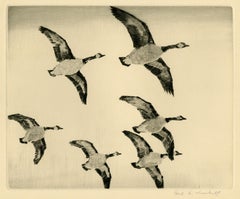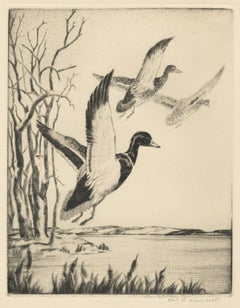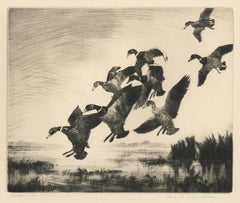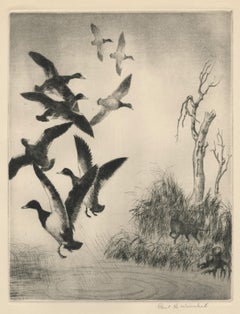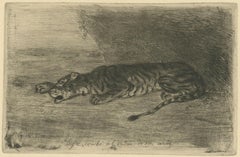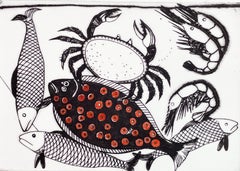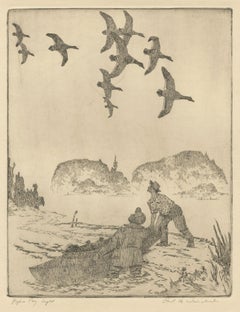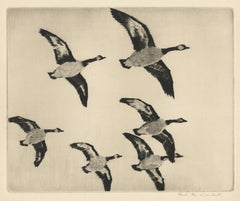Paul H. Winchell Animal Prints
American, 1903-1972
Paul H. Winchell (1903 – 1971) was a printmaker, illustrator, teacher, and gilder according to Crump, 2009 (Minnesota Prints and Printmakers, 1900- 1945, Minnesota Historical Society Press). He was the son of Mrs. Looman Winchell of Shepherd Rd as noted in a 1937 newspaper article (Painsville, O. Telegraph). Winchell grew up in North Perry, Ohio and then studied and worked as an instructor at the Art Institute of Chicago. He studied with Leon Kroll (1884 – 1974), Boris Anisfeld (1878-1973), Daniel Garber (1880 – 1958), Charles Woodbury (1864 – 1940), George Oberteuffer, (1878 – 1940) and Elmer A. Forsberg (1883 – 1950), although it was not stated whether each of these teachers was in Chicago or elsewhere. According to the Minneapolis School of Art Faculty Summer 1930 brochure he was an instructor at the Art Institute of Chicago for three years. According to the 1940 – 1941 catalogue, which provided a short biography and a photograph of the artist, he traveled and studied in Spain, Africa, Italy, England, Germany, and France. According to Crump, Winchell did not receive support from either the Public Works of Art Project or the Minnesota WPA Federal Art Project.
In Minneapolis, where he was an instructor at the Minneapolis School of Art, he first appeared in 1930 in the Minneapolis Institute of Arts’ Sixteenth Annual Exhibition of the Work of Minneapolis and St. Paul Artists, where he exhibited three oil paintings. He received second honorable mention in oil painting for #69 Old Family. In 1931 he received third honorable mention in oil painting for #64, his Portrait of Miss C. Winchell exhibited his work subsequently in other Minneapolis Institute of Arts (MIA) exhibitions in 1933 and 1935 – 1938. According to Crump he also received first prize in the prints category at the Minnesota State Fair in 1940. Other exhibitions included the St. Paul Gallery and School of Art, the Midwestern Artists Association, and the Kansas City Art Institute. His bio at the Minneapolis School of Art also noted he exhibited at the Chicago Art Institute. According to Crump’s summary, based on information from Who Was Who in American Art, 1564-1975 (by Peter Falk), Winchell’s knowledge of gilding as a craft for framing may have provided income supplemental to his teaching.
At the Minneapolis School of Art Winchell taught figure sketching, figure study, elementary illustration, and drawing. His Figure Sketching class in the summer of 1930 is described as follows:to
4
Overall Width
to
Overall Height
to
8
195
161
113
94
4
4
2
2
2
2
2
1
1
4
4
4
Artist: Paul H. Winchell
Canadian Geese in Flight
By Paul H. Winchell
Located in Fairlawn, OH
Canadian Geese in Flight
Drypoint printed with plate tone in the sky
c. 1940's
Signed in pencil lower right
Condition: Excellent
Image/Plate size: 8 3/8 x 10 1/4 inches
Provenanc...
Category
1940s American Realist Paul H. Winchell Animal Prints
Materials
Drypoint
Untitled (Three Ducks Taking to Flight)
By Paul H. Winchell
Located in Fairlawn, OH
Untitled (Three Ducks Taking to Flight)
Drypoint, c. 1940
Signed lower right
Provenance: Estate of the Artist
Winchell Heirs by descent
Condition: Excellent
Image/Plate size: 10 1/2 x 8 1/4 inches
Sheet size: 12 1/2 x 10 5/16 inches
Created while the artist was a commercial artist working in Minneapolis, after his tenure of being an instructor at the Minneapolis Institute of Art in the 1930's.
Paul H. Winchell (1903 – 1971) was a printmaker, illustrator, teacher, and gilder according to Crump, 2009 (Minnesota Prints and Printmakers, 1900- 1945, Minnesota Historical Society Press). He was the son of Mrs. Looman Winchell of Shepherd Rd as noted in a 1937 newspaper article (Painsville, O. Telegraph). Winchell grew up in North Perry, Ohio and then studied and worked as an instructor at the Art Institute of Chicago. He studied with Leon Kroll (1884 – 1974), Boris Anisfeld...
Category
1940s American Realist Paul H. Winchell Animal Prints
Materials
Drypoint
Dropping In
By Paul H. Winchell
Located in Fairlawn, OH
Dropping In
Drypoint, c. 1940
Signed lower right (see photo)
Titled lower left
Condition: Excellent
Brown paper tape around the sheet edges from
the printing and air dryi...
Category
1940s American Realist Paul H. Winchell Animal Prints
Materials
Drypoint
untitled (Duck taking to flight, flushed by a dog)
By Paul H. Winchell
Located in Fairlawn, OH
untitled (Duck taking to flight, flushed by a dog)
Drypoint & Aquatint, c. 1940
signed lower right
Created while the artist was a commercial artist working in Minneapolis, after his ...
Category
1940s American Realist Paul H. Winchell Animal Prints
Materials
Drypoint
Related Items
Tigre couché à l'entrée de son antre (Tiger Lying at the Entrance to its Lair)
By Eugène Delacroix
Located in Middletown, NY
Etching, drypoint, and roulette on watermarked Hallines cream laid paper, 3 3/4 x 5 7/8 inches (95 x 148 mm), full margins. A very good impression of this charming image, with all of...
Category
Early 19th Century Realist Paul H. Winchell Animal Prints
Materials
Laid Paper, Drypoint, Etching
Crab, Plaice and Prawns
By Colin Self
Located in New York, NY
A contemporary of David Hockney and Peter Blake, Colin Self is an important British printmaker whose innovative etching techniques and novel use of found materials have defined his d...
Category
Early 2000s Expressionist Paul H. Winchell Animal Prints
Materials
Drypoint
Salvador Dalì (1904-1989) - The Elephant and Jupiter's Monkey - Drypoint etching
By Salvador Dalí
Located in Varese, IT
Rare deluxe issue printed on extremely fine Japanese paper (hand colored in stencil).
Limited edition, numbered 235/250 in lower left corner.
Signed in pencil by artist in lower rig...
Category
1970s Surrealist Paul H. Winchell Animal Prints
Materials
Paper, Watercolor, Drypoint, Etching
Salvador DalíSalvador Dalì (1904-1989) - The Elephant and Jupiter's Monkey - Drypoint etching, 1974
$3,835
H 28.35 in W 36.23 in D 0.79 in
Salvador Dali - Le Cerf from Le Bestiaire de la Fontaine - Signed Engraving
By Salvador Dalí
Located in Collonge Bellerive, Geneve, CH
SALVADOR DALI
Le Cerf se voyant dans l'eau from Le Bestiaire de la Fontaine
1974
Hand signed by Dali
Edition: /250
The dimensions of the image are 22.8 x 15.7 inches on 31 x 23.2 in...
Category
1970s Surrealist Paul H. Winchell Animal Prints
Materials
Drypoint, Aquatint
$2,950
H 29.93 in W 22.84 in D 0.04 in
20th century drypoint etching figurative animal print black and white signed
By John Edward Costigan
Located in Milwaukee, WI
"Boy With Cows" is an original drypoint etching by John Edward Costigan. It depicts a young boy with three cows standing in a watering hole. The artist si...
Category
1930s American Realist Paul H. Winchell Animal Prints
Materials
Drypoint, Etching
The Goldfinch, 1942 (Histoire Naturelle - Textes de Buffon, B.348 )
By Pablo Picasso
Located in Greenwich, CT
The Goldfinch is an aquatint and drypoint print on chine from one of the deluxe copies of Picasso's 1942 Histoire Naturelle - Textes de Buffon series. The image size is 11.2 x 8.25 inches, unsigned as issued, and framed in a contemporary silver and gray moulding. One of about 36 prints that exist with Picasso's remarqued title in French, from the edition of 262 (there were 226 portfolios, some with additional sets on varying papers).
Catalogue - Cramer #37
The exceptional etchings from Picasso’s Histoire Naturelle – Textes de Buffon are a masterful combination of sugar-lift aquatint and drypoint, showcasing a full range of gray tonalities. The etchings of animals, birds and insects are considered some of the most beautiful and most unusual examples of Picasso’s graphic work.
Roger Lacourière, Picasso’s master printer, pulled the prints for each etching between 1939-1942. It was Lacourière who taught Picasso the sugar-lift aquatint technique which allowed him to mimic the effect of brushstrokes in these etched images. Picasso first explored the technique in his plates for the Vollard Suite, but it was in the creation of the Buffon images that he fully realized its stunning, painterly potential.
For the edition, 226 portfolios were produced with the first thirty-six counting as deluxe compilations. These rare deluxe sets were on diverse papers (chine, japon or vergé ancien) and each included a complete additional suite showing Picasso’s title remarques along the bottom. As such, the remarqued versions of the prints are quite rare with just thirty-six of each produced for the edition (with the exception of The Wolf which is never remarqued – the image always fills the entire etching plate).
These prints are based on the writings of French naturalist Georges-Louis Leclerc, Comte de Buffon, who extensively documented the natural world in his monumental work Histoire Naturelle. Picasso’s association with the project to illustrate parts of the Buffon came during a tumultuous time in European history – the prelude to, and early years of, World War II. As the continent was ravaged, Picasso lived through the disaster in Paris, which the Germans occupied in 1940. These prints could be seen as a political statement – Picasso channeling his artistic expression into a form of resistance art...
Category
20th Century Modern Paul H. Winchell Animal Prints
Materials
Drypoint, Aquatint
$12,850
H 24.125 in W 20.5 in
The White Eagle, 1942 (Histoire Naturelle - Textes de Buffon, B.340)
By Pablo Picasso
Located in Greenwich, CT
The White Eagle is an aquatint and drypoint print on chine from one of the deluxe copies of Picasso's 1942 Histoire Naturelle - Textes de Buffon series. The image size is 10.5 x 8.15 inches, unsigned as issued, and framed in a contemporary silver and gray moulding. One of about 36 prints that exist with Picasso's remarqued title in French, from the edition of 262 (there were 226 portfolios, some with additional sets on varying papers).
Catalogue - Cramer #37
The exceptional etchings from Picasso’s Histoire Naturelle – Textes de Buffon are a masterful combination of sugar-lift aquatint and drypoint, showcasing a full range of gray tonalities. The etchings of animals, birds and insects are considered some of the most beautiful and most unusual examples of Picasso’s graphic work.
Roger Lacourière, Picasso’s master printer, pulled the prints for each etching between 1939-1942. It was Lacourière who taught Picasso the sugar-lift aquatint technique which allowed him to mimic the effect of brushstrokes in these etched images. Picasso first explored the technique in his plates for the Vollard Suite, but it was in the creation of the Buffon images that he fully realized its stunning, painterly potential.
For the edition, 226 portfolios were produced with the first thirty-six counting as deluxe compilations. These rare deluxe sets were on diverse papers (chine, japon or vergé ancien) and each included a complete additional suite showing Picasso’s title remarques along the bottom. As such, the remarqued versions of the prints are quite rare with just thirty-six of each produced for the edition (with the exception of The Wolf which is never remarqued – the image always fills the entire etching plate).
These prints are based on the writings of French naturalist Georges-Louis Leclerc, Comte de Buffon, who extensively documented the natural world in his monumental work Histoire Naturelle. Picasso’s association with the project to illustrate parts of the Buffon came during a tumultuous time in European history – the prelude to, and early years of, World War II. As the continent was ravaged, Picasso lived through the disaster in Paris, which the Germans occupied in 1940. These prints could be seen as a political statement – Picasso channeling his artistic expression into a form of resistance art...
Category
20th Century Modern Paul H. Winchell Animal Prints
Materials
Drypoint, Aquatint
$9,850
H 24.125 in W 20.5 in
The Deer, 1942 (Histoire Naturelle - Textes de Buffon, B.336)
By Pablo Picasso
Located in Greenwich, CT
The Deer is an aquatint and drypoint print on chine from one of the deluxe copies of Picasso's 1942 Histoire Naturelle - Textes de Buffon series. The image size is 10.5 x 8.15 inches, unsigned as issued, and framed in a contemporary silver and gray moulding. One of about 36 prints that exist with Picasso's remarqued title in French, from the edition of 262 (there were 226 portfolios, some with additional sets on varying papers).
Catalogue - Cramer #37
The exceptional etchings from Picasso’s Histoire Naturelle – Textes de Buffon are a masterful combination of sugar-lift aquatint and drypoint, showcasing a full range of gray tonalities. The etchings of animals, birds and insects are considered some of the most beautiful and most unusual examples of Picasso’s graphic work.
Roger Lacourière, Picasso’s master printer, pulled the prints for each etching between 1939-1942. It was Lacourière who taught Picasso the sugar-lift aquatint technique which allowed him to mimic the effect of brushstrokes in these etched images. Picasso first explored the technique in his plates for the Vollard Suite, but it was in the creation of the Buffon images that he fully realized its stunning, painterly potential.
For the edition, 226 portfolios were produced with the first thirty-six counting as deluxe compilations. These rare deluxe sets were on diverse papers (chine, japon or vergé ancien) and each included a complete additional suite showing Picasso’s title remarques along the bottom. As such, the remarqued versions of the prints are quite rare with just thirty-six of each produced for the edition (with the exception of The Wolf which is never remarqued – the image always fills the entire etching plate).
These prints are based on the writings of French naturalist Georges-Louis Leclerc, Comte de Buffon, who extensively documented the natural world in his monumental work Histoire Naturelle. Picasso’s association with the project to illustrate parts of the Buffon came during a tumultuous time in European history – the prelude to, and early years of, World War II. As the continent was ravaged, Picasso lived through the disaster in Paris, which the Germans occupied in 1940. These prints could be seen as a political statement – Picasso channeling his artistic expression into a form of resistance art...
Category
20th Century Modern Paul H. Winchell Animal Prints
Materials
Drypoint, Aquatint
$12,850
H 24.125 in W 20.5 in
The Mother Hen, 1942 (Histoire Naturelle - Textes de Buffon, B.345)
By Pablo Picasso
Located in Greenwich, CT
The Mother Hen is an aquatint and drypoint print on chine from one of the deluxe copies of Picasso's 1942 Histoire Naturelle - Textes de Buffon series. The image size is 10.6 x 8 inc...
Category
20th Century Modern Paul H. Winchell Animal Prints
Materials
Drypoint, Aquatint
$12,850
H 24.125 in W 20.5 in
Salvador Dali "The Raven and the Fox"
By Salvador Dalí
Located in Boston, MA
Artist: Dali, Salvador
Title: The Raven and the Fox
Series: Le Bestiaire de la Fontaine
Date: 1974
Medium: drypoint with color added by stencil
Framed Dimensions: 35.75" x 28"
S...
Category
1970s Surrealist Paul H. Winchell Animal Prints
Materials
Drypoint, Stencil
Salvador Dali - The Rider and the Deer - Handsigned Engraving
By Salvador Dalí
Located in Collonge Bellerive, Geneve, CH
Salvador Dali - The Rider and the Deer - Handsigned Engraving
1974
Hand signed by Dali
Edition: /250
The dimensions of the image are 22.8 x 15.7 inches on 3...
Category
1970s Surrealist Paul H. Winchell Animal Prints
Materials
Drypoint, Aquatint
$2,950
H 29.93 in W 22.84 in D 0.04 in
Hooked Salmon, angling fish etching by George Marples, circa 1920
Located in Melbourne, Victoria
Marples was a painter, etcher, writer on ornithology, and principal of Huddersfield, Hull and Liverpool School of Art. He specialized in etchings of fish...
Category
1920s Other Art Style Paul H. Winchell Animal Prints
Materials
Etching, Drypoint
$850
H 8.15 in W 12.13 in
Previously Available Items
Before Day Light
By Paul H. Winchell
Located in Fairlawn, OH
Before Day Light
Drypoint, c. 1940
Signed lower right (see photo)
Titled lower left (see photo)
Created while the artist was a commercial artist working in Minneapolis.
In the 1930’s...
Category
1940s American Realist Paul H. Winchell Animal Prints
Materials
Drypoint
Canadian Geese in Flight
By Paul H. Winchell
Located in Fairlawn, OH
Canadian Geese in Flight
Drypoint, c. 1940
Signed in pencil (see photo)
Small edition
Provenance: estate of the artist, by descent
Created while the artist was a commercial artist wo...
Category
1940s American Impressionist Paul H. Winchell Animal Prints
Materials
Drypoint
Canadian Geese in Flight
By Paul H. Winchell
Located in Fairlawn, OH
Canadian Geese in Flight
Drypoint, c. 1940
Signed in pencil (see photo)
Small edition
Provenance: estate of the artist, by descent
Created while the ar...
Category
1940s American Impressionist Paul H. Winchell Animal Prints
Materials
Drypoint
Paul H. Winchell animal prints for sale on 1stDibs.
Find a wide variety of authentic Paul H. Winchell animal prints available for sale on 1stDibs. You can also browse by medium to find art by Paul H. Winchell in drypoint, engraving, etching and more. Not every interior allows for large Paul H. Winchell animal prints, so small editions measuring 5 inches across are available. Customers who are interested in this artist might also find the work of Lionel Edwards, Currier & Ives, and Louis Prang. Paul H. Winchell animal prints prices can differ depending upon medium, time period and other attributes. On 1stDibs, the price for these items starts at $300 and tops out at $750, while the average work can sell for $350.
